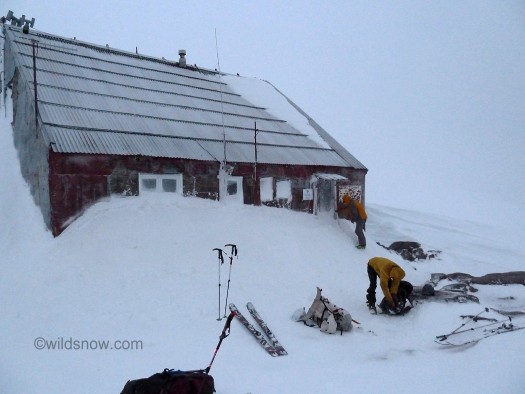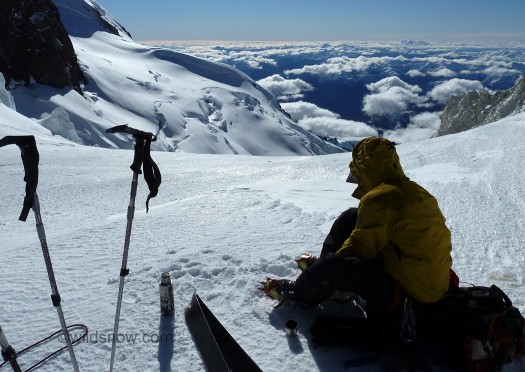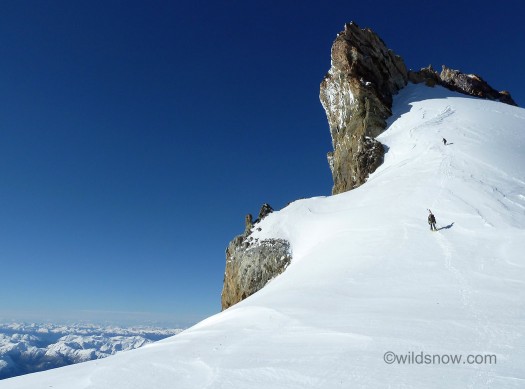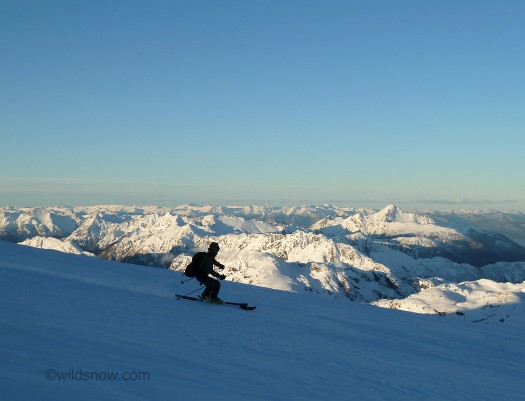An extinct volcano, Tronador rises far above everything around it, jagged and glaciated. Unlike many of the other high peaks in the area, it isn’t a symmetrical cone shaped volcano. After seeing Tronador From the ridges above Refugio Frey, it was clear that we needed to ski it.
Bariloche is close to Tronador, but access isn’t easy without a car. We decided to rent a small car for a few days. We picked it up in the morning, and puzzle-pieced all our gear inside. The poor neighborhoods we drove through on our way out of town provided quite a contrast to the relatively rich town center, known as the “Aspen of the Andes.”
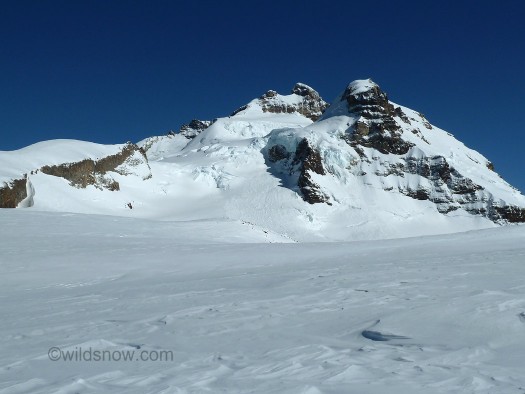
The summit of Tronador, as seen from above Refugio Otto Meiling. The snow perfectly hides numerous crevasses. Mandatory rope travel.
A few hours later, we arrived at the village of Pampa Linda. After hearing how the park service requires you to leave your trip itinerary and names with them, we searched around for the correct employee. After consulting the police and a few shops, it seemed the park ranger was out of the office. We left a note on the door, and started walking up the trail. A former road that is popular with trekkers in the summer, the trail was easy and well signed. After a few hours, we heard the sound of an ATV roaring up the road behind us. It turned out to be the missing park ranger, who confirmed our return time and that we had avalanche beacons, before turning around and roaring back down the trail. I doubt a park ranger would be able to do the same in the States!
In Spanish, Tronador means “thunderer.” As we hiked up the trail the mountain lived up to its name. Every 20 minutes or so, we would be treated to the sound of distant tons of ice calving off the mountain’s many seracs. After a few hours, the road turned into a trail, and became covered in snow. Soon enough we lost the approach route entirely, and began bushwacking through steep, thick bushes. The underbrush slowed us down, but got much easier as we gained the ridge that led to the refugio.
Above timberline the route follows a ridge that splits two glaciers. We traversed across wind loaded slopes above a 1000+ foot cliff. “Lets check out the snow over there, cause if there’s an avalanche, we’re dead,” somebody said as we gingerly made our way along the safest route through the wind and clouds. We safely reached the refugio a little before dark. We dug out the door, and ate a quick meal of pasta as we waited for it to air out, a precaution against hanta virus.
We went to bed in a complete white-out, but remained hopeful that the next day would bring good weather. I woke at seven, and alas, looked out the window to find nothing but wind and fog. I slept a bit longer, and woke again to find the clouds had sank, and we were now alone with Tronador, above a sea of clouds.
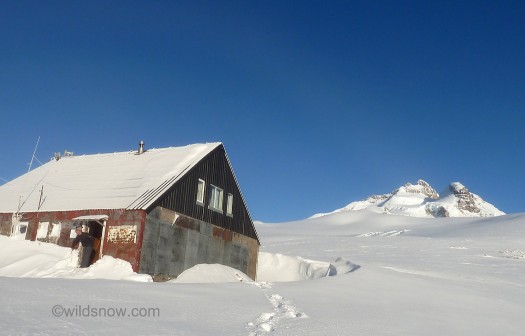
Bluebird skies above Tronador and the refugio in the morning. Quite the change from one hour earlier, when we woke inside a cloud.
After the extra hour of sleep, we got going a little late, leaving the hut around 10:30. We roped up almost immediately, not knowing anything about the nearby glaciers, or even where they were exactly. After an hour on the rope, we had made our way up the low angled glacier and decided to head left to follow a rocky ridge rather than find our way through the steep, crevassed glacier in front of us. The weather was perfect, bluebird, hardly any wind, and the clouds in the valleys slowly disappearing.
Given our close proximity to some rocks, our late start, and the fact that we hadn’t noticed any crevasses thus far, we decided to unrope for a bit. After a few minutes however, I noticed I was a few feet from a thin, open crevasse, so we donned the rope again. A smart idea, as it turned out. The next hour involved some of the toughest glacier navigation I have done. What looked to be a mellow ridge was in fact a dense crevasse field, perfectly hidden by thin, wind sculpted snow. I began probing every few feet with my ski pole. Several times I found a wide crevasse covered by a smooth, inches thick shell of snow, completely hidden. After making our way through, we ended up on an icy, knife edge ridge surrounded by crevasses. Not wanting to venture out unroped, we belayed down onto the flatter glacier, and started our roped, cautious travel once again.
We reached a 50-foot wide crevasse, and ate lunch on an safe, exposed patch of firn. After lunch, I took the lead once more, and began probing a wide depression in the snow ahead. A few probes found nothing, so I ventured a bit farther, and probed further out. In an instant, a 10 x 30 foot section of snow collapsed, revealing yet another wide, deep crevasse. We set up a belay, and I gingerly crossed one of the sections that had not collapsed. It held.
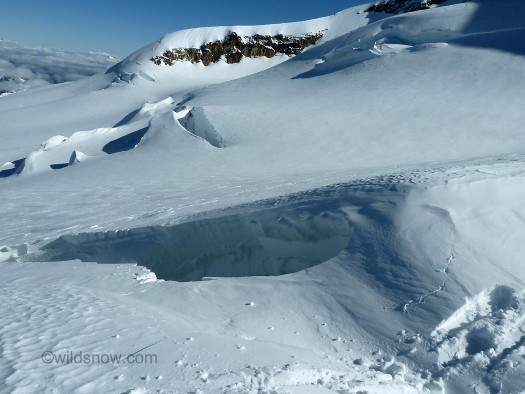
Happy to have a rope! You can see my tracks where I was standing when the snow covering this big guy collapsed.
The glacier became less crevassed, but we kept the rope on until we reached the saddle between two of the three peaks of Tronador, Pico Argentina (our intended summit), and Pico Anon (the highest summit, protected by ramparts of loose, volcanic rock). I was relieved to have gotten through some of the toughest crevasse navigation I’ve done, complicated by thin eggshell bridges formed by the Patagonian winds.
We quickly cramponed our way toward the summit, only to find the last 30 feet a jumble of volcanic choss. It was already 5:00, and we didn’t see any easy way up, so we decided to ski from there. The skiing was beautiful. Of course the snow was wind affected, but the views were stunning. We seemed to be miles above all the other peaks, except a few distant volcanoes.
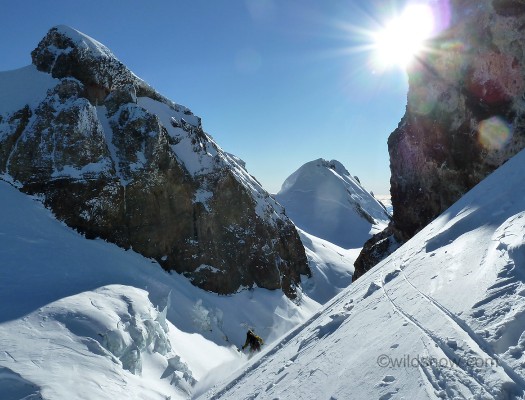
Skyler skiing down the summit ridge, with the highest summit to the left, and the Chilean summit in the distance. The Chilean summit looks to have some nice skiing from the top.
We made our way through the crevasses, and reached the refugio just before dark. We stoked the fire and made a big meal of pasta before going to bed. The next morning we woke late and made our way back to the car in Pampa Linda. The weather was cloudy and rainy. It seemed the sketchy South American weather report had been right for once, and we had got the weather window. I slept on the way back to Bariloche where we feasted on potatoes and cheap Argentinian steak that night.
Wow! Another great ski trip in South America. I think Tronador was my favorite high Andean peak yet, although maybe that’s just because we just skied it. Tomorrow we are taking the bus to the Chilean border, and the trailhead for Volcan Lanin. I’d better get some sleep.
Louie Dawson earned his Bachelor Degree in Industrial Design from Western Washington University in 2014. When he’s not skiing Mount Baker or somewhere equally as snowy, he’s thinking about new products to make ski mountaineering more fun and safe.

